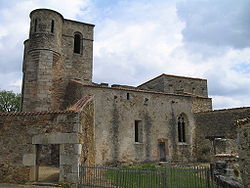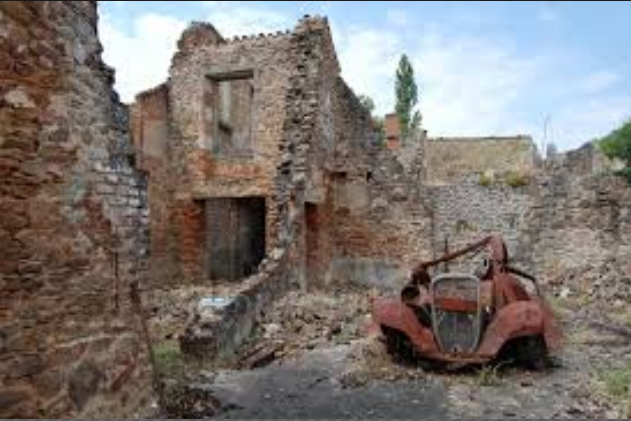On D+4 after the Normandy invasion of WW2, the 2nd Panzer Division of the Waffen SS was passing through the Limousin region, in west-central France. “Das Reich” had been ordered to help stop the Allied advance, when SS-Sturmbannführer Adolf Diekmann received word that SS officer Helmut Kämpfe was being held by French Resistance forces in the village of Oradour-sur-Vayres.

Diekmann’s battalion sealed off the nearby village of Oradour-sur-Glane, seemingly unaware of their own confusion between the two villages.
Everyone in the town was ordered to assemble in the village square, for examination of identity papers. The entire population of the village was there, plus another half-dozen unfortunates, caught riding their bicycles at the wrong place, and the wrong time.
 The women and children of Oradour-sur-Glane were locked in a village church while German soldiers looted the town. The men were taken to a half-dozen barns and sheds, where the machine guns were already set up.
The women and children of Oradour-sur-Glane were locked in a village church while German soldiers looted the town. The men were taken to a half-dozen barns and sheds, where the machine guns were already set up.
The Germans aimed for the legs when they opened fire, intending to inflict as much pain as possible. Five escaped in the confusion before the SS lit the barn on fire. 190 men were burned alive.
 Nazi soldiers then lit an incendiary device in the church, and gunned down 247 women and 205 children as they tried to escape.
Nazi soldiers then lit an incendiary device in the church, and gunned down 247 women and 205 children as they tried to escape.
47-year-old Marguerite Rouffanche escaped out a back window, followed by a young woman and child. All three were shot. Rouffanche alone escaped alive, crawling to some pea bushes where she hid until next morning.
642 inhabitants of Oradour-sur-Glane, aged one week to 90 years, were shot to death, burned alive or some combination of the two, in a few hours. The village was then razed to the ground.
Raymond J. Murphy, a 20-year-old American B-17 navigator shot down over France and hidden by the French Resistance, reported seeing a baby who’d been crucified.
After the war, a new village was built on a nearby site. French President Charles de Gaulle ordered that the “old” village remain as it is; a monument for all time to criminally insane governing ideologies, and the malignity of collective punishment.

Generals Erwin Rommel and Walter Gleiniger, German commander in Limoges, protested the senseless act of brutality. Even the SS Regimental commander agreed and began an investigation, but that came to naught. Within days, Diekmann and most of the men who had carried out the massacre, had been killed in combat.
The ghost village at the old Oradour-sur-Glane stands mute witness to this day, to the savagery committed by black-clad Schutzstaffel units in countless places like the French towns of Tulle, Ascq, Maillé, Robert-Espagne, and Clermont-en-Argonne; the Polish villages of Michniów, Wanaty and Krasowo-Częstki and the city of Warsaw; the Soviet village of Kortelisy; the Lithuanian village of Pirčiupiai; the Czechoslovakian villages of Ležáky and Lidice; the Greek towns of Kalavryta and Distomo; the Dutch town of Putten; the Yugoslavian towns of Kragujevac and Kraljevo and the village of Dražgoše, in what is now Slovenia; the Norwegian village of Telavåg; the Italian villages of Sant’Anna di Stazzema and Marzabotto.

And on. And on. And on.
 French President Jacques Chirac dedicated a memorial museum in 1999, the “Centre de la mémoire d’Oradour“. The village stands today as those Nazi soldiers left it, seventy-four years ago today. It may be the most forlorn place on earth.
French President Jacques Chirac dedicated a memorial museum in 1999, the “Centre de la mémoire d’Oradour“. The village stands today as those Nazi soldiers left it, seventy-four years ago today. It may be the most forlorn place on earth.
The story was featured on the 1974 British television series “The World at War”, narrated by Sir Laurence Olivier, who intones these words for the first and final episodes of the program: “Down this road, on  a summer day in 1944. . . The soldiers came. Nobody lives here now. They stayed only a few hours. When they had gone, the community which had lived for a thousand years. . . was dead. This is Oradour-sur-Glane, in France. The day the soldiers came, the people were gathered together. The men were taken to garages and barns, the women and children were led down this road . . . and they were driven. . . into this church. Here, they heard the firing as their men were shot. Then. . . they were killed too. A few weeks later, many of those who had done the killing were themselves dead, in battle. They never rebuilt Oradour. Its ruins are a memorial. Its martyrdom stands for thousands upon thousands of other martyrdoms in Poland, in Russia, in Burma, in China, in a World at War”.
a summer day in 1944. . . The soldiers came. Nobody lives here now. They stayed only a few hours. When they had gone, the community which had lived for a thousand years. . . was dead. This is Oradour-sur-Glane, in France. The day the soldiers came, the people were gathered together. The men were taken to garages and barns, the women and children were led down this road . . . and they were driven. . . into this church. Here, they heard the firing as their men were shot. Then. . . they were killed too. A few weeks later, many of those who had done the killing were themselves dead, in battle. They never rebuilt Oradour. Its ruins are a memorial. Its martyrdom stands for thousands upon thousands of other martyrdoms in Poland, in Russia, in Burma, in China, in a World at War”.




Just awful 😦
LikeLiked by 1 person
How anyone can do such a thing is just sickening.
LikeLiked by 1 person
Amen.
LikeLiked by 1 person
Reblogged this on MacCoach and commented:
Was war nochmal an einem 10. Juni? Woran könnte man sich heute erinnern? Ach ja! Der D-Day. Schaut mal hier……
LikeLike